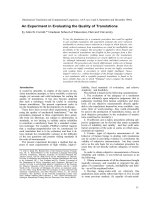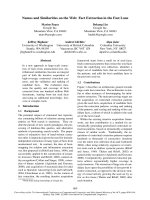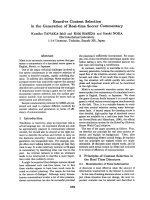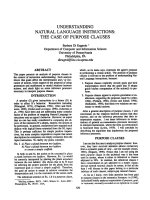Báo cáo khoa học: " Randomized multicenter trial on the effect of radiotherapy for plantar Fasciitis (painful heel spur) using very low doses – a study protocol" pot
Bạn đang xem bản rút gọn của tài liệu. Xem và tải ngay bản đầy đủ của tài liệu tại đây (218.42 KB, 5 trang )
BioMed Central
Page 1 of 5
(page number not for citation purposes)
Radiation Oncology
Open Access
Study protocol
Randomized multicenter trial on the effect of radiotherapy for
plantar Fasciitis (painful heel spur) using very low doses – a study
protocol
Marcus Niewald*
1
, M Heinrich Seegenschmiedt
2
, Oliver Micke
3
,
Stefan Gräber
4
for the GCGBD (German cooperative group on the
radiotherapy for benign diseases) of the DEGRO (German society for
radiation oncology)
Address:
1
Department of Radiooncology, Saarland University Hospital, Kirrberger Str. 1, D-66421 Homburg, Germany,
2
Deptartment of
Radiooncology, Alfried Krupp Hospital, Alfried-Krupp-Str. 21, D-45117 Essen, Germany,
3
Department of Radiooncology, St. Franziskus Hospital,
Kiskerstr. 26, D-33615 Bielefeld, Germany and
4
Institute for Medical Biometrics, Epidemiology and Medical Informatics, Saarland University
Hospital, Kirrberger Str. 1, D-66421 Homburg, Germany
Email: Marcus Niewald* - ; M Heinrich Seegenschmiedt - ;
Oliver Micke - ; Stefan Gräber -
* Corresponding author
Abstract
Background: A lot of retrospective data concerning the effect of radiotherapy on the painful heel
spur (plantar fasciitis) is available in the literature. Nevertheless, a randomized proof of this effect
is still missing. Thus, the GCGBD (German cooperative group on radiotherapy for benign diseases)
of the DEGRO (German Society for Radiation Oncology) decided to start a randomized
multicenter trial in order to find out if the effect of a conventional total dose is superior compared
to that of a very low dose.
Methods/Design: In a prospective, controlled and randomized phase III trial two radiotherapy
schedules are to be compared:
standard arm: total dose 6.0 Gy in single fractions of 1.0 Gy applied twice a week
experimental arm: total dose 0.6 Gy in single fractions of 0.1 Gy applied twice a week (acting as a
placebo)
Patients aged over 40 years who have been diagnosed clinically and radiologically to be suffering
from a painful heel spur for at least six months can be included. Former trauma, surgery or
radiotherapy to the heel are not allowed nor are patients with a severe psychiatric disease or
women during pregnancy and breastfeeding. According to the statistical power calculation 100
patients have to be enrolled into each arm.
After having obtaining a written informed consent a patient is randomized by the statistician to one
of the arms mentioned above. After radiotherapy, the patients are seen first every six weeks, then
regularly up to 48 months after therapy, they additionally receive a questionnaire every six weeks
after the follow-up examinations.
Published: 18 September 2008
Radiation Oncology 2008, 3:27 doi:10.1186/1748-717X-3-27
Received: 18 August 2008
Accepted: 18 September 2008
This article is available from: />© 2008 Niewald et al; licensee BioMed Central Ltd.
This is an Open Access article distributed under the terms of the Creative Commons Attribution License ( />),
which permits unrestricted use, distribution, and reproduction in any medium, provided the original work is properly cited.
Radiation Oncology 2008, 3:27 />Page 2 of 5
(page number not for citation purposes)
The effect is measured using several target variables (scores): Calcaneodynia-score according to
Rowe et al., SF-12 score, and visual analogue scale of pain. The most important endpoint is the pain
relief three months after therapy. Patients with an inadequate result are offered a second
radiotherapy series applying the standard dose (equally in both arms).
This trial protocol has been approved by the expert panel of the DEGRO as well as by the Ethics
committee of the Saarland Physicians' Chamber. The trial is supported by a HOMFOR grant
(Saarland University Research Grant).
Trial registration: Current controlled trials ISRCTN94220918
Background
Introduction
To our knowledge, the painful heel spur was first
described by Plettner et al.[1] in 1900 summarizing their
radiological findings of exostoses situated at the plantar
part of the calcaneus or at the insertion point of the
plantar aponeurosis. Various authors give values for the
incidence of 8 to 88% of an unselected population [2-4].
Risk factors may be old age, obesity, and foot or leg
deformities. Histopathologically, the heel spur is a
fibroostosis promoted by mechanical stress to the plantar
aponeurosis, slowly and continuously growing into its
insertion region[5]. In a more chronical stage of the dis-
ease, the degenerative changes cause a local inflammation
of the plantar aponeurosis (plantar fasciitis), which
should be well differentiated from – for example – rheu-
matoid arthritis.
Clinical findings
Heel spurs – even when clearly visible on X-rays – often
are completely asymptomatic. 16% of these patients have
local pain getting worse over weeks to months under the
heel, which can further extend to the foot or the lower
limb. Local pressure to the medial edge of the calcaneus
may be painful[5]. In our own experience, most of the
patients cannot stand or walk for a long time, the pain
may be even worse during the first minutes of rest after a
walk.
Radiological findings
Conventional x-rays are the gold standard in the diagnosis
of a heel spur, usually lateral pictures of the calcaneus are
taken. They show a calcified spur at the inferior side of the
calcaneus. The intensity of pain is not regarded to be
dependent on the size of the spur.
Additionally a local ultrasound examination can be per-
formed in order to examine the swelling and irritation of
the plantar fascia. A bone scan may be positive showing
local inflammation which remits after successful therapy.
Conventional therapy methods
A great variety of therapy methods have been tested in the
past but none of them has provided a high level of evi-
dence. Ice, heat, ultrasound, radiofrequency, laser beams
and extracorporal shock wave therapy have been applied.
Steroids and local anesthetics injected into the plantar fas-
cia, and oral analgetic medication (NSAID) have been
prescribed. Immobilization of the foot using special
splints and adjustable shoes were applied. Physiotherapy
was performed[2,3].
Iontophoresis using dexamethasone was found to be
superior to iontophoresis with placebo (NaCl)[6]. Extra-
corporal shock wave therapy yielded a complete pain
relief in up to 68% of the patients[7]. A randomized trial
published by Batt et al.[8] showed that better results were
recorded by adding local immobilization of the foot in
maximum dorsal flexion during night to a standard ther-
apy (NSAID, splints) compared to this standard therapy
alone. According to Powell et al.[9], a splint applied
immediately after diagnosis was as effective as an applica-
tion one month later. In further randomized trials
mechanical therapy using ortheses was found better than
application of local analgesics only, silicon shoe inserts
were found superior to other shoe adjustments[10], func-
tional foot ortheses were found to be more advantageous
than simple heel splints[11]. Most of these methods and
their results have been summarized in a Cochrane
review[12]
Surgery
As a general consensus, patients will only undergo surgery
in the case that conservative therapy methods have not
yielded sufficient pain relief. Heider et al.[13] report good
to excellent results in 26 out of 28 feet after surgery.
Favourable results were recorded as well using endoscopic
release of the plantar fascia[14]. Nevertheless, complica-
tions like fractures of the calcaneus[15] as well as negative
biomechanical consequences of plantar fascia relief have
been reported[16].
Radiation Oncology 2008, 3:27 />Page 3 of 5
(page number not for citation purposes)
Radiotherapy – experimental data
The anti-inflammatory effect of radiation therapy has
been known for a long time and has been reported in
numerous publications. Nevertheless, the exact mecha-
nism is still unclear. Some of the models discussed are:
Improvement of blood perfusion in the tissue due to an
influence of radiation on the endothelium, release of
cytokines and enzymes, influence on the local parts of the
vegetative nervous system, and modification of the pH-
value in the tissue [17-20]. In animal experiments, Steffen
et al. noticed anti-inflammatory effects of low-dose radio-
therapy (6 Gy) on antigen-induced arthritis in rabbits
[21]. Hildebrandt et al. have shown that low-dose radia-
tion effects can be explained by an influence on molecular
mechanisms and inflammation mediators [22-24].
Radiotherapy – clinical results
Numerous retrospective trials have shown that low-dose
radiotherapy for the painful heel spur has a good analgetic
effect, pain relief has been noticed in 65 – 90% of the
patients [17,20,25-28]. However, a certain placebo effect
is still under discussion [25]. Goldie et al. examined this
effect in 399 patients. They found a response in 60% of
the patients whether irradiated or not; these results made
the effect of radiotherapy questionable [29]. The trial,
however, has been criticised because of missing clearly
defined endpoints: furthermore the therapy was started in
an acute stage of the diseases and the authors did not wait
for spontaneous pain remissions.
In the meantime, several more modern trials have shown
the analgetic effect of radiotherapy. Seegenschmiedt et al.
[2] performed a randomized trial treating 141 patients
(170 heels) for painful heel spur using orthovoltage, com-
paring three radiotherapy schedules: 1 Gy/fraction up to
12 Gy, 0.3 Gy/fraction up to 3 Gy and 0.5 Gy/fraction up
to 5 Gy. The overall complete pain relief was reported in
67–72% of the patients. The best results were seen after a
total dose of 5 Gy. These results were confirmed by
Schäfer et al. using a telecobalt machine, they achieved a
complete pain relief in 58% [25]. Heyd et al. used 6 MV
photon beams of a linear accelerator, they noticed a fre-
quency of pain relief of 69% [4]. The same author group
published a prospective randomized trial recently [30]
comparing the effect of a total dose of 3 Gy (single frac-
tion 0.5 Gy twice weekly) to that of a total dose of 6 Gy
(single fraction 1 Gy twice weekly). Radiotherapy was
reported very efficient, however a dependency from dose
could not be noticed. Mücke et al. looked for prognostic
factors for pain relief in a multicenter trial [31]. They
found an overall response in 60.9%. Significant favoura-
ble prognostic factors for pain relief were a patient's age
over 58 years, the use of megavoltage techniques and the
number of therapy series required.
Radiotherapy – side effects and risks
Physicians of other specialities sometimes refuse to refer
patients to radiotherapy because of the fear of local side
effects such as impairment of gonad function or induction
of malignancies. But we are concerned here with low
doses applied to the extremities. Neither local toxicity nor
tumour induction have been reported yet [26,32,33]. The
dose to the gonads is comparable to that after radiodiag-
nostic interventions [20,34-36].
Radiotherapy – conclusion
Summarizing the data taken from the literature it can be
concluded that a low-dose radiotherapy for painful heel
spur with total doses ranging from 3–12 Gy is effective in
the vast majority of patients and the side effects are negli-
gible. However, a placebo effect cannot be excluded
totally. Thus, randomised trials (like the present one)
using defined criteria and scores are necessary [37].
Design
Inclusion criteria
- Symptoms and clinical diagnosis of a painful heel spur
(tenderness of the calcaneus)
- limitation of the painless walking distance
- duration of symptoms more than six months
- radiological proof of heel spur
- facultatively ultrasound, MRT or bone scan
- Karnofsky performance index > = 70%
- Age > = 40 years
- Written informed consent
Exclusion criteria
- previous radiotherapy to the foot
- previous trauma to the foot (fracture, rupture of tendon)
- rheumatic or vascular diseases, lymphatic edema
- pregnancy, breastfeeding
- severe psychiatric disorder
Informed consent
Before enrolment, an informed consent is to be obtained
from all patients after detailed information and explana-
tions concerning the effect and potential toxicity of ther-
apy, alternative therapy methods, follow-up
examinations, and data protection issues.
Radiation Oncology 2008, 3:27 />Page 4 of 5
(page number not for citation purposes)
Therapy protocol
After enrolment and filling in the SF-12-, calcaneodynia
and VAS (visual analogue scale of pain) score forms, the
patient is randomly assigned to either of the following
therapy protocols:
Arm A: Total dose of 6 Gy in 6 single fractions of 1 Gy
applied twice weekly (standard arm)
Arm B: Total dose of 0.6 Gy in 6 single fractions of 0.1 Gy
applied twice weekly (experimental arm).
The dosage in Arm B was chosen first to examine if very
low doses are effective at all, second it acts as a placebo
irradiation; a sham irradiation was regarded unethical.
Follow-up examinations are performed every six weeks
after radiotherapy either consisting of a personal examina-
tion (6,12,24,36,48 weeks after radiotherapy) or a ques-
tionnaire (after 18,30,42 weeks): every single patient is
followed-up for 48 weeks. In the case of an unfavourable
response to the radiotherapy after twelve weeks or more
the patients will be offered a second treatment with the
same technology but applying the standard dose of 6 Gy,
single fractions of 1 Gy twice weekly. Such patients remain
in their arms with the result classified as unsatisfactory.
The final evaluation will be performed when 200 patients
have been followed-up for 48 weeks. Interim evaluations
will be performed after 100 and 150 patients.
Primary endpoints
- SF-12 sum score [38]
- Calcaneodynia sum score [2,39]
- VAS score
Secondary endpoints
- SF-12 single score
- Calcaneodynia single score
- Event-free interval
Randomisation and statistics
Randomisation is performed by the statistician (S.G.) as a
block randomisation. The patients are assigned randomly
to one therapy arm with an equal probability for both
arms. 200 patients are required in order to detect a differ-
ence of 10% in the SF-12 and calcaneodynia scores (scat-
ter 25%) with a power of 80% and an error probability of
5%.
Radiotherapy methods
Radiotherapy is performed using orthovoltage (200–250
kV) devices, telecobalt machines or megavoltage x-ray
irradiation (maximum energy 6 MV, if only higher ener-
gies are available, a bolus with a thickness of 1 cm must
be applied).
Orthovoltage therapy is applied using a plantar direct
field with a strip of bolus material affixed to the heel lat-
erally and dorsally. The dose should be normed to a spe-
cial reference point (for example in 5 mm tissue depth).
The dose is calculated using the tables present in every
department. Megavoltage therapy is performed using iso-
centric parallel-opposing portals, the ICRU reference
point is defined in the center of the calcaneus.
The target volume should consist of the calcaneus and the
plantar aponeurosis, a 2 cm wide safety margin should be
added. The gonads must be shielded as well as possible.
Quality assurance
The quality of the data is to be controlled as follows:
- Quality assurance questionnaire signed by all partici-
pants (physician and physicist)
- Visits to the centers
- Participants will be asked to send simulation x-rays or
portal imaging picture as well as therapy plans of ran-
domly selected patients
- check of the data entered into the database
Ethics
This trial protocol has been approved by the expert panel
of the DEGRO as well as by the Ethics committee of the
Saarland Physicians' Chamber. The trial is supported by a
HOMFOR grant (Saarland University Research Grant).
Present status of the trial
In the meantime 49 patients have been enrolled. Ten
more centers have stated their interest to participate, three
of them already have the agreement of their local ethics
committee.
Competing interests
The authors declare that they have no competing interests.
Authors' contributions
MN was responsible for the final version of this protocol
in German language and wrote this manuscript. MHS had
the idea to perform this trial and promoted it, he was a co-
author of the German study protocol and is responsible
for quality assurance procedures. OM was responsible for
Radiation Oncology 2008, 3:27 />Page 5 of 5
(page number not for citation purposes)
the former versions of the German study protocol, espe-
cially the evaluation of the literature. SG is responsible for
the statistical part of this protocol and will check the final
evaluation.
Acknowledgements
Supported by a HOMFOR grant (Saarland University research grant).
The authors wish to acknowledge Mr. AG Page for his meticulous correc-
tion of this manuscript and a lot of very useful advice.
References
1. Plettner P: Exostosen des Fersenbeins. Jahresber Ges Natur
Heilkunde. Dresden; 1900.
2. Seegenschmiedt MH, Keilholz L, Katalinic A, Stecken A, Sauer R:
Heel spur: radiation therapy for refractory pain-results with
three treatment concepts. Radiology 1996, 200:271-276.
3. Seegenschmiedt MH, Keilholz L, Stecken A, Katalinic A, Sauer R:
[Radiotherapy of plantar heel spurs: indications, technique,
clinical results at different dose concepts]. Strahlenther Onkol
1996, 172:376-383.
4. Heyd R, Uhder K, Straßmann G, Schneider L, Zamboglou N: Ergeb-
nisse der analgetischen Radiotherapie bei inflammator-
ischen Fersensporn mit 6 MV Photonen. Röntgenpraxis 1996,
52:26-32.
5. Schreiber A, Zollinger H: Entzündungen/Fersenbeinsporne. In
Orthopädie in Klinik und Praxis Stuttgart: Thieme; 1985:441-445.
6. Gudeman SD, Eisele SA, Heidt RS, Colosimo AJ, Stoupe AL: Treat-
ment of plantar fasciitis by iontophoresis of 0.4% dexameth-
asome: a randomized double blind placebo controlled study.
Amer J Sports Med 1997, 25:312-316.
7. Sistermann R, Katthagen BD: [5-years lithotripsy of plantar of
plantar heel spur: experiences and results-a follow-up study
after 36.9 months]. Z Orthop Ihre Grenzgeb 1998, 136(5):402-406.
8. Batt ME: Plantar fasciitis: a prospective randomized clinical
trial of the tension night splint. Clin J Sports Med 1996, 6:158-162.
9. Powell M, Post WR, Keener J, Wearden S: Effective treatment of
chronic plantar fasciitis with dorsiflexion night splints: a
crossover prospective randomized outcome study. Foot Ankle
Int 1998, 19:10-18.
10. Pfeffer G: Comparison of custom and prefabricated ortheses
in the initial treatment of proximal plantar fasciitis. Foot Ankle
Int 1999, 20(4):214-221.
11. Turlik MA, Donatelli TJ, Veremis MG: A comparison of shoe
inserts in relieving mechanical heel pain. Foot 1999, 9:84-87.
12. Crawford F, Atkins D, Edwards J: Interventions for treating
plantar heel pain. The Cochrane Library
2001.
13. Heider CC: Ergebnisse nach operativer Resektion von
plantaren Fersenbeinspornen – eine retrospektive Studie.
Orthopädische Universitätsklinik und Poliklinik Hamburg-Eppendorf. Ham-
burg 1998:40.
14. Tomczak RL, Haverstock BD: Retrospective comparison of
endoscopic plantar fasciotomy to open plantar fasciotomy
with heel spur resection for chronic plantar fasciitis/heel
spur syndrome. J Foot Ankle Surg 1995, 34:305-311.
15. Hoffman SJ, Thul JR: Fractures of the calcaneus secondary to
heel spur surgery. An analysis and case report. J Am Podiatr
Med Assoc 1985, 75(5):267-271.
16. Powell M, Post WR, Keener J, Wearden S: Biomechanical conse-
quences of sequential plantar fascia release. Foot Ankle Int
1998, 19:149-152.
17. Basche S, Drescher W, Mohr K: Ergebnisse der Röntgenstrahl-
entherapie beim Fersensporn. Radiobiol Radiother 1980,
21:233-236.
18. Lindner H, Freislederer R: Langzeitergebnisse der Bestrahlung
von degenerativen Skeletterkrankungen. Strahlenther Onkol
1982, 158:217-223.
19. Reichel WS: Die Röntgentherapie des Schmerzes. Strahlenther
Onkol 1949, 80:483-534.
20. Zschache H: Ergebnisse der Röntgenschwachbestrahlung.
Radiobiol Radiother 1972, 13:181-186.
21. Steffen C, Müller C, Stellamor K, Zeithofer J: Influence of X-ray
treatment on antigen-induced experimental arthritis. Annals
Rheum Dis 1982, 41:532-537.
22. Hildebrandt G, Seed MP, Freemantle CN, Alam CA, Colville-Nash PR,
Trott KR: Mechanisms of the anti-inflammatory activity of
low-dose radiation therapy. Int Journal Radiat Biol 1998,
74:367-378.
23. Hildebrandt G, Jahns J, Hindemith M, Spranger S, Sack U, Kinne RW,
Madaj-Sterba P, Wolf U, Kamprad F: Effects of low dose radiation
therapy on adjuvant induced arthritis in rats. Int J Radiat Biol
2000, 76:1143-1153.
24. Hildebrandt G, Seed MP, Freemantle CN, Alam CA, Colville-Nash PR,
Trott KR:
Effects of low dose ionizing radiation on murine
chronic granulomatous tissue. Strahlenther Onkol 1998,
174:580-588.
25. Schafer U, Micke O, Glashorster M, Rube C, Prott FJ, Willich N: [The
radiotherapy treatment of painful calcaneal spurs]. Strahlen-
ther Onkol 1995, 171:202-206.
26. Keim H: Mitteilung über die Durchführung der Entzündungs-
bestrahlung mit dem Telekobaltgerät. Strahlenther 1965,
127:49-52.
27. Mantell BS: The management of benign conditions. Radiotherapy in clinical
practice London: Butterworth's; 1986.
28. von Pannewitz G: Degenerative Erkrankungen Berlin-Heidelberg-New
York: Springer; 1965.
29. Goldie I, Rosengren B, Moberg E, Hedelin F: Evaluation of the radi-
ation treatment of painful conditions of the locomotor sys-
tem. Acta Radiol Ther Phys Biol 1970, 9:311-322.
30. Heyd R, Tselis N, Ackermann H, Röddiger SJ, Zamboglou N: Radia-
tion therapy for painful heel sours. Strahlenther Onkol 2007,
183:3-9.
31. Muecke R, Micke O, Reichl B, Heyder R, Prott FJ, Seegenschmiedt
MH, Glatzel M, Schneider O, Schafer U, Kundt G: Demographic,
clinical and treatment related predictors for event-free
probability following low-dose radiotherapy for painful heel
spurs – a retrospective multicenter study of 502 patients.
Acta oncol 2007, 46:239-246.
32. Mitrov G, Harbov I: Unsere Erfahrungen mit der Strahlenther-
apie von nichttumorartigen Erkrankungen. Radiobiol Radiother
1967, 8:419.
33. Sautter-Biehl ML, Liebermeister E, Scheurig H, Heinze HG: Analge-
tische Bestrahlung degenerativ-entzündlicher Skeletter-
krankungen. Dtsch Med Wschr 1993, 118:493-498.
34. Gaertner C, Schuettauf M, Below M, Motorina LI, Michina ZP: Zur
strahlentherapeutischen Behandlung chronisch-rezidi-
vierender Skelettveränderungen an der Klinik für Osteolo-
gie (Charité). Radiobiol Radiother 1988, 29:687-696.
35. Fuchs G: Die Strahlenbelastung der Gonaden in der Röntgen-
therapie.
Strahlenther Onkol 1960, 111:297-300.
36. Schuhmann E, Lademann W: Zur Gonadenbelastung bei der
Strahlentherapie nicht-tumoröser Erkrankungen. Radiobiol
Radiother 1965, 6:455-457.
37. Micke O, Seegenschmiedt MH: SF36/SF12 – Werkzeuge zur
Evaluation der Lebensqualität bei der Strahlentherapie von
degenerativen Erkrankungen. In Radiotherapie bei gutartigen
Erkrankungen – 15 Kolloquium Radioonkologie/Strahlentherapie Edited
by: Seegenschmiedt MH, Makoski B. Altenberge: Diplodocus Verlag;
2001:51-64.
38. Bullinger M, Morfeld M, Kohlmann T, Nantke J, Bussche H van den,
Dodt B, Dunkelberg S, Kirchberger I, Krüger-Bödecker A, Lachmann
A, Lang K, Mathis C, Mittag O, Peters A, Raspe H-H, Schulz H: Der
SF-36 in der rehabilitationswissenschaftlichen Forschung –
Ergebnisse aus dem Norddeutschen Verbund für Rehabilita-
tionsforschung (NVRF) im Förderschwerpunkt Rehabilita-
tionswissenschaften. Rehabilitation 2003, 42:218-225.
39. Rowe C, Sakellarides HT, Freeman PA, Sorbie C: Fractures of the
os calcis. JAMA 1963, 184:920-923.









